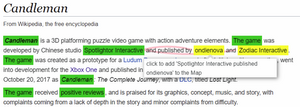Information
- Publication Type: Bachelor Thesis
- Workgroup(s)/Project(s):
- Date: October 2021
- Date (Start): April 2021
- Date (End): October 2021
- Matrikelnummer: 11777706
- First Supervisor: Manuela Waldner
Abstract
Concept maps are a well-known method of structured representation of knowledge. They are represented as a node-link diagram that showcases different concepts and their relations to each other, which are often extracted from unstructured text. Manual generation of such concept maps can be a tedious task, but fully automated approaches are often not able to satisfy qualitative expectations. Semi-automated methods have shown to be a satisfying compromise between these two. It is especially important that the manual aspect of creating a concept map is as intuitive and easy as possible so that the user’s workflow is not interrupted, and tasks can be completed efficiently. Therefore, it is the graphical user interface that plays a critical role in guaranteeing a satisfying experience and swift completion of tasks.It is therefore the aim of this thesis to create an environment, in which users are able to extract meaningful concepts from arbitrary websites and connect these concepts to existing knowledge structures. In other words, it should visually convey how new, unseen information fits to the knowledge they already have. For this purpose, an extension to the Google Chrome browser is presented in this thesis, that allows the user to analyze the text on any website on the internet with a provided natural language processing software. Concepts and relations can then be highlighted in the original text to visualize their connection to existing knowledge. At the user’s choice, new concepts, relations, and combinations of the two can be added to existing concept maps. These concept maps can be automatically visualized as a node-link diagram.
With the help of a small user evaluation, we conclude that the approach has definite potential but still lacks the reliability, especially with the automatic text processing and concept extraction, for real-world use-cases.
Additional Files and Images
Weblinks
- GitHub
Code for the Browser Extension
BibTeX
@bachelorsthesis{stoff-concepMap-2021,
title = "Concept Map Mining as Browser Extension",
author = "Mario Stoff",
year = "2021",
abstract = "Concept maps are a well-known method of structured
representation of knowledge. They are represented as a
node-link diagram that showcases different concepts and
their relations to each other, which are often extracted
from unstructured text. Manual generation of such concept
maps can be a tedious task, but fully automated approaches
are often not able to satisfy qualitative expectations.
Semi-automated methods have shown to be a satisfying
compromise between these two. It is especially important
that the manual aspect of creating a concept map is as
intuitive and easy as possible so that the user’s workflow
is not interrupted, and tasks can be completed efficiently.
Therefore, it is the graphical user interface that plays a
critical role in guaranteeing a satisfying experience and
swift completion of tasks. It is therefore the aim of this
thesis to create an environment, in which users are able to
extract meaningful concepts from arbitrary websites and
connect these concepts to existing knowledge structures. In
other words, it should visually convey how new, unseen
information fits to the knowledge they already have. For
this purpose, an extension to the Google Chrome browser is
presented in this thesis, that allows the user to analyze
the text on any website on the internet with a provided
natural language processing software. Concepts and relations
can then be highlighted in the original text to visualize
their connection to existing knowledge. At the user’s
choice, new concepts, relations, and combinations of the two
can be added to existing concept maps. These concept maps
can be automatically visualized as a node-link diagram.
With the help of a small user evaluation, we conclude that
the approach has definite potential but still lacks the
reliability, especially with the automatic text processing
and concept extraction, for real-world use-cases.",
month = oct,
address = "Favoritenstrasse 9-11/E193-02, A-1040 Vienna, Austria",
school = "Research Unit of Computer Graphics, Institute of Visual
Computing and Human-Centered Technology, Faculty of
Informatics, TU Wien ",
URL = "https://www.cg.tuwien.ac.at/research/publications/2021/stoff-concepMap-2021/",
}

 thesis
thesis

